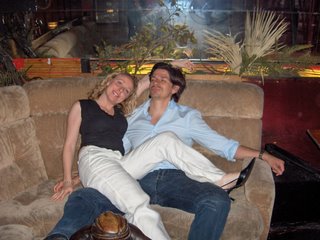[JK: just one more "lesson" after this to go! Relief is in sight! ;)]
This lesson expands on Part II (History) by delving deeper into the 1994 Genocide.
The Strategy of Ethnic Division
President Juvenal Habyarimana, nearing the end of two decades in power, was losing popularity among Rwandans when the RPF attacked from Uganda on October 1 1990. At first Habyarimana did not see the rebels as a serious threat, although they stated their intention to remove him as well as to make possible the return of the hundreds of thousands of Rwandan refugees who had lived in exile for a generation. The President and his close colleagues decided, however, to exaggerate the RPF threat as a way to pull dissident Hutu back to his side and they began portraying Tutsi inside Rwanda as RPF collaborators. For three and a half years, this elite worked to re-define the population of Rwanda into “Rwandans,” meaning those who backed the President, and the “ibyitso” or “accomplices of the enemy,” meaning the Tutsi minority and Hutu opposed to him.
In the campaign to create hatred and fear of the Tutsi, the Habyarimana circle played upon memories of past domination by the minority and on the legacy of the revolution that overthrew their rule and drove many into exile in 1959. Singling out most Tutsi was easy: the law required that all Rwandans be registered according to ethnic group. Residents of the countryside, where most Rwandans lived, generally knew who was Tutsi even without such documentation. In addition, many Tutsi were recognisable from their physical appearance.
But shattering bonds between Hutu and Tutsi was not easy. For centuries they had shared a single language, a common history, the same ideas and cultural practices. They lived next to one another, attended the same schools and churches, worked in the same offices, and drank in the same bars. A considerable number of Rwandans were of mixed parentage, the offspring of Hutu-Tutsi marriages. In addition, to make ethnic identity the predominant issue, Habyarimana and his supporters had to erase — or at least reduce — distinctions within the ranks of the Hutu themselves, especially those between people of the northwest and of other regions, those between adherents of different political factions, and those between the rich and the poor.
From the start, those in power were prepared to use physical attacks as well as verbal abuse to achieve their ends. They directed massacres of hundreds of Tutsi in mid-October 1990 and in 5 other episodes before the 1994 Genocide. In some incidents, Habyarimana’s supporters killed Hutu opponents — their principal political challengers — as well as Tutsi, their declared ideological target.
Habyarimana was obliged to end his party’s monopoly of power in 1991 and rival parties sprouted quickly to contend for popular support. Several of them created youth wings ready to fight to defend partisan interests. By early 1992, Habyarimana had begun providing military training to the youth of his party, who were thus transformed into the militia known as the Interahamwe ("Those Who Stand Together" or "Those Who Attack Together"). Massacres of Tutsi and other crimes by the Interahamwe went unpunished, as did some attacks by other groups, thus fostering a sense that violence for political ends was “normal”.
Preparations for Slaughter
Through attacks, virulent propaganda, and persistent political manoeuvering, Habyarimana and his group signficantly widened divisions between Hutu and Tutsi by the end of 1992. During 1993, a dramatic military advance by the RPF and a peace settlement favourable to them — which also stipulated that officials, including the President, could be prosecuted for past abuses — confronted Habyarimana and his supporters with the imminent loss of power. These same events heightened concerns among a broader group of Hutu, including some not previously identified with Habyarimana. Increasingly anxious about RPF ambitions, this growing group was attracted by the new Radio Télévision Libre des Mille Collines (RTLM) and by a movement called Hutu Power, which cut across party lines and embodied the ethnic solidarity that Habyarimana had championed for three years. In late October, Tutsi soldiers in neighboring Burundi seized and murdered the Hutu President, freely and fairly elected only months before. In massacres touched off by the assassination, tens of thousands of Burundians died, both Hutu and Tutsi. The crime, energetically exploited by RTLM, confirmed the fears of many Rwandan Hutu that Tutsi would not share power and swelled the numbers supporting Hutu Power. Meanwhile the Habyarimana circle was preparing the organization and logistics to attack the minority. During 1993, some loyalists from Habyarimana’s party expanded the recruitment and training of the Interahamwe. But others, perhaps concerned that the militia were too tainted by partisan rivalries, proposed a “civilian self-defense force” which was to recruit young men through administrative rather than party channels. The recruits were to be trained by former soldiers or communal police who would direct them in attacking the “enemy” in their communities. In early 1993, Colonel Théoneste Bagosora sketched out elements of the program in his appointment book, the intellectual Ferdinand Nahimana advocated such a force in a letter to friends and colleagues, and administrators began preparing lists of former soldiers who could command its ranks.
Soldiers and political leaders distributed firearms to militia and other supporters of Habyarimana in 1993 and early 1994, but Bagosora and others concluded that firearms were too costly to distribute to all participants in the “civilian self-defense” program (NOTE: it is also important to know that France was supplying weapons to militia forces). They advocated arming most of the young men with such weapons as machetes. Businessmen close to Habyarimana imported large numbers of machetes, enough to arm every third adult Hutu male.
Aware of these preparations, the RPF anticipated further conflict. They too recruited more supporters and troops and, in violation of the Peace Accords, increased the number of their soldiers and firearms in Kigali. They understood the risk that renewed combat would pose to Tutsi, particularly those who had come out publically in support of the RPF in the preceding months, and warned foreign observers to this effect.
The Attack
By late March 1994, Hutu Power leaders were determined to slaughter massive numbers of Tutsi and Hutu opposed to Habyarimana, both to rid themselves of these “accomplices” and to shatter the peace agreement. They had soldiers and militia ready to attack the targeted victims in Kigali and in such outlying areas as Cyangugu in the southwest, Gisenyi in the northwest and Murambi in the northeast. But elsewhere they had not completed the arrangements. In the centre of the country, they had successfully disseminated the doctrine of Hutu Power, but they were unsure how many ordinary people would transform that ideology into action. In other areas, particularly in the south, they had not won large numbers of supporters to the idea, far less organised for them to implement it.
On April 6, the plane carrying President Habyarimana was shot down, a crime for which the responsibility has never been established. A small group of his close associates — who may or may not have been involved in killing him — decided to execute the planned extermination. The Presidential Guard and other troops commanded by Colonel Bagosora, backed by militia, murdered Hutu government officials and leaders of the political opposition, creating a vacuum in which Bagosora and his supporters could take control. Soldiers and militia also began systematically slaughtering Tutsi. Within hours, military officers and administrators far from the capital dispatched soldiers and militia to kill Tutsi and Hutu political leaders in their local areas. After months of warnings, rumours and prior attacks, the violence struck panic among Rwandans and foreigners alike. The rapidity of the first killings gave the impression of large numbers of assailants, but in fact their impact resulted more from ruthlessness and organisation than from great numbers.
The killing swiftly spread from Kigali to all corners of the country. Between April 6th and mid-July 1994, a genocide of unprecedented swiftness is estimated to have left between 800,000 to 1,071,000 Tutsis and moderate Hutus dead at the hands of organised bands of militias.
Most of the victims were killed in their villages or in towns, often by their neighbours and fellow villagers. The militia members mostly killed their victims by chopping them up with machetes, although some army units used rifles. In some towns the victims were forcibly crammed into churches and school buildings, where Hutu extremist gangs massacred them. In June about 3,000 Tutsis sought refuge in a Catholic church in Kivumu. Local Interahamwe then used bulldozers supplied by the local police to knock down the church building. People who tried to escape were hacked down with machetes.
For the rest of the story, please read "Leave None to Tell the Story: Genocide in Rwanda" by Human Rights Watch or read Wikipedia's background on the Rwandan Genocide.




